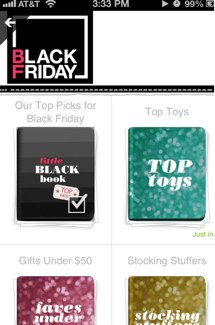For most consumer-focused apps, a redesign can be a daunting experience. If users don’t love it, a startup must either go back to the drawing board or stick with something and hope that users will eventually respond positively. And then there are the rare cases when usage explodes following a redesign. Shopkick says it is experiencing that moment, following a complete redesign of its mobile shopping app in October.
For background, Shopkick’s free mobile app for iPhone or Android rewards consumers for walking into the store. The app uses proprietary technology that involves in-store hardware that emits an inaudible signal that gets picked up by the shopper’s mobile phone. Shoppers are also rewarded for other actions, such as scanning barcodes or trying on clothes, for example. Shopkick’s retail partners include big names like Target, Best Buy, Macy’s, and others.
Engagement with the app, says founder Cyriac Roeding, has skyrocketed since the redesign. Users have reviewed products more than 340 million times, which amounts to over 100 products per user per day. If this engagement keeps up, Shopkick will reach 1 billion product views within 12 weeks. With the old app, it took the startup one and a half years to reach 1 billion product views.
Roeding explains that users are actually using the app when they are not in the store. This is due to the new content-rich “lookbooks,” which include must-have items by store or brand, and give users a view into what products are new at a particular store. Users can also save these products to wish lists for items to be purchased on the next shopping trip.
He compares the feature to a “personalized store catalogue or Sunday Circular,” but this is with you when you walk in to the store. Any items saved in a user’s account can be pushed via notifications as soon as a user walks into a given store.
Shopkick also says that over half of all users (52 percent) now prepare their shopping trips at home by building up walk-in kicks (more products viewed at home means more kicks earned at walk-in). They are more valuable shoppers for retailers and brands, because they are more prepared.
Additionally, the number of store walk-ins shot up 40 percent in the first week of Shopkick’s redesign compared to the month before (September). For the first time, shopkick reached over 1 million verified walk-ins to partner stores in a month. For comparison, just six months ago it was fewer than 500,000.
Lastly, the new version of the app drove up the revenue generated for partners by 50 percent. In the first 10 months of 2012, Shopkick drove around $130 million in revenue for its partners. After the redesign, Shopkick’s monthly run rate shot up to $26 million in revenue driven for its partners; up from $15 million previously and $8 million last year.
The redesign, of course, was timed with the beginning of the holiday shopping season. But Roeding is fairly confident that the amount of engagement in the app is not a reflection of the holiday rush. He believes that the new features and UI represent the future of shopping. The startup now offers both an in-home, leanback experience as well as an in-store retail focus.
This is a turning point for us, he explains. The test for Shopkick will be whether this engagement can actually grow, or if things will level off post-holiday. Regardless, the success of Shopkick’s app has made it clear that shoppers want both a leanback, in-home experience as well as a way to research and find products while in-stores. We’re seeing eBay and Amazon move down this path; and I’d bet more retailers join the mix.
